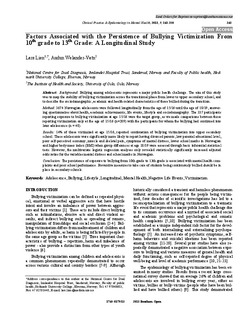Factors associated with the persistence of bullying victimization from 10th grade to 13th grade: a longitudinal study
Journal article, Peer reviewed
Permanent lenke
http://hdl.handle.net/11250/134650Utgivelsesdato
2013Metadata
Vis full innførselSamlinger
Originalversjon
Lien, L. & Welander-Vatn, A. (2013). Factors associated with the persistence of bullying victimization from 10th grade to 13th grade: a longitudinal study. Clinical practice and Epidemiology in Mental Health 9, 243-250. doi: 10.2174/1745017901309010243. 10.2174/1745017901309010243Sammendrag
Abstract: Background: Bullying among adolescents represents a major public health challenge. The aim of this study
was to map the stability of bullying victimization across the transitional phase from lower to upper secondary school, and
to describe the sociodemographic, academic and health-related characteristics of those bullied during the transition.
Method: 3674 Norwegian adolescents were followed longitudinally from the age of 15/16 until the age of 18/19, answering
questionnaires about health, academic achievements, life events, lifestyle and sociodemography. The 337 participants
reporting exposure to bullying victimization at age 15/16 were the target group, as we made comparisons between those
reporting victimization only at the age of 15/16 (n=289) with the participants for whom the bullying had continued into
later adolescence (n = 48).
Results: 14% of those victimized at age 15/16, reported continuation of bullying victimization into upper secondary
school. These adolescents were significantly more likely to report having divorced parents, low parental educational level,
poor self-perceived economy, muscle and skeletal pain, symptoms of mental distress, lower school marks in Norwegian
and higher body-mass index (BMI) when group differences at age 18/19 were assessed through basic inferential statistical
tests. However, the multivariate logistic regression analyses only revealed statistically significantly increased adjusted
odds ratios for the variables mental distress and school-marks in Norwegian.
Conclusion: The persistence of exposure to bullying from 10th grade to 13th grade is associated with mental health complaints
and poor school performance. Preventive measures to take care of students being continuously bullied should be in
place in secondary schools.
Beskrivelse
Vitenskapelig, fagfellevurdert artikkel
